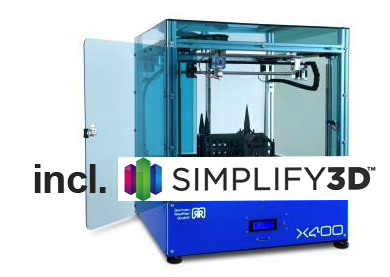![]() I’m never surprised when people come up to me and ask me what 3D printers can be used for. Although, I tend to laugh a little on the inside, I usually provide them with a laundry list of potential uses. I then go on to list a plethora of well-known companies that are using the technology in one form or another in the creation of products. Many of the products we use on an everyday basis are available partially due to 3D printing.
I’m never surprised when people come up to me and ask me what 3D printers can be used for. Although, I tend to laugh a little on the inside, I usually provide them with a laundry list of potential uses. I then go on to list a plethora of well-known companies that are using the technology in one form or another in the creation of products. Many of the products we use on an everyday basis are available partially due to 3D printing.
One company which I certainly never mentioned, nor even had a clue that they were using 3D printing in their production cycle is Hama, a German-based photo and electronics technology manufacturer, who has over 18,000 products to their name. While, we haven’t previously heard of the company using 3D printing in the manufacturing process, I probably would have guessed that a company as large as them, employing over 2500 people, would have some use for the technology. Typically when we think of large companies utilizing 3D printers to create products, we envision industrial level machines from the likes of 3D Systems or Stratasys. However, to our surprise, this isn’t the case for Hama, at least not entirely.
 Hama, has been using a relatively popular German-based desktop 3D printer from German RepRap, called the X400. This is an FDM-based machine which costs under 4,000 Euros, and it has helped Hama shorten the development time for both their products and their packaging, while also helping reduce production costs.
Hama, has been using a relatively popular German-based desktop 3D printer from German RepRap, called the X400. This is an FDM-based machine which costs under 4,000 Euros, and it has helped Hama shorten the development time for both their products and their packaging, while also helping reduce production costs.
Using the X400 3D printer, Hama takes CAD drawings of new products, such as a mouse for a computer and 3D prints it in a matter of hours.
“Since we’ve been using the 3D printer, product development has been much more efficient,” Nils Krietenstein, head of product design at Hama explains. “Previously, we had to send the data to our production partners in the Far East and wait till the sample was sent back to us. This procedure made any necessary modifications very time consuming. Thanks to the 3D printer we can now complete and assess modifications and adaptions much faster.”
In this real-life example, the first prototypes of the mice are 3D printed on the X400, using white PLA plastic. Designers are then able to use the 3D prints to evaluate the ergonomics, design elements, and some functionality of the device, prior to having a mold made in order to create the end-use product. They typically use white PLA as it is the best color for assessing various designs, and the prototypes are printed using a 0.4mm nozzle with a 0.25mm layer height.
 While the mouse is just one of the products that have been prototyped by Hama on the X400 3D printer, the company also uses this method for prototyping other products, which include headphones, USB sticks, packaging and more.
While the mouse is just one of the products that have been prototyped by Hama on the X400 3D printer, the company also uses this method for prototyping other products, which include headphones, USB sticks, packaging and more.
“Up to 60% of 3D printer usage is for developing the accessories whilst the remaining 40% is for the packaging prototypes,” says Krietenstein.
The prototyping of packaging may be just as important to Hama as the products themselves. In order to make sure that the presentation of a product packaging is to their liking, prototypes of so-called inner trays are also 3D printed on the X400. The trays hold products in position within the packaging. The 3D printed mold for the trays are polished and given a special coating in order to fully test their feasibility.
“We then deep draw the foil and thus produce a handful of packaging samples in order for the team to assess them on the simulated sales wall.” This is considerably cheaper and environmentally friendlier than the alternative of cutting a mold for this in aluminum. “This enables us to print up to ten molds, sometimes even more. Should something prove not to be such an optimum design, we can simply print a new deep-draw mold overnight.”
While the company isn’t using an industrial level 3D printer which could potentially cost upwards of $200,000, the quality provided by the German RepRap X400 is high enough and precise enough to do as they need.
Subscribe to Our Email Newsletter
Stay up-to-date on all the latest news from the 3D printing industry and receive information and offers from third party vendors.
Print Services
Upload your 3D Models and get them printed quickly and efficiently.
You May Also Like
3D Printing News Briefs, June 28, 2025: Defense Accelerator, Surgical Models, & More
In this weekend’s 3D Printing News Briefs, 3YOURMIND was selected to join an EU Defense Accelerator, and PTC has announced model-based definition (MBD) capabilities within Onshape. Finally, a study out...
3D Printing News Briefs, June 7, 2025: Digital Inventory, Thermal Management Solutions, & More
In this weekend’s 3D Printing News Briefs, UK-based 3D printing bureau 3D People responds to global instability, and AEWIN chose Fabric8Labs’ technology for advanced thermal management solutions. We’ll end with...
Low-Cost Binocular Indirect Ophthalmoscope Made with CAD Software & Bambu Lab X1C
3D printing is increasingly used in the fabrication of diagnostic equipment, including ophthalmology, which is a medical specialty that deals with the diagnosis and treatment of eye conditions and diseases....
3D Printing News Briefs, May 17, 2025: Color-Changing Materials, Humanoid Robot, & More
We’re covering research innovations in today’s 3D Printing News Briefs! First, Penn Engineering developed 3D printed materials that change color under stress, and UC Berkeley researchers created an open source,...


































